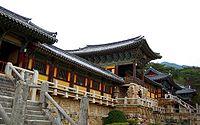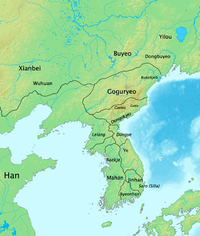- Dongye
-
Dongye Hangul 동예 Hanja 東濊 Revised Romanization Dongye McCune–Reischauer Tongye Dongye, which means the Eastern Ye, was a Korean chiefdom which occupied portions of the northeastern Korean peninsula from roughly 3rd-century BCE to around early 5th-century. It bordered Goguryeo and Okjeo to the north, Jinhan to the south, and China's Lelang Commandery to the west. Today, this territory consists of the provinces of South Hamgyŏng and Kangwon in North Korea, and Gangwon in South Korea.
Contents
History
History of Korea 
This article is part of a seriesPrehistory Jeulmun period Mumun period Gojoseon ?–108 BCE Wiman Joseon 194 BCE–108 BCE Proto–Three Kingdoms 300–57 BCE Buyeo, Goguryeo, Okjeo, Dongye Jin state, Samhan (Ma, Byeon, Jin) Four Commanderies of Han Three Kingdoms 57 BCE–668 Goguryeo 37 BCE–668 Baekje 18 BCE–660 Silla 57 BCE–935 Gaya 42–562 North and South States 698–926 Unified Silla 668–935 Balhae 698–926 Later Three Kingdoms 892–936 Taebong, Hubaekje, Silla Goryeo Dynasty 918–1392 Joseon Dynasty 1392–1897 Korean Empire 1897–1910 Colonial Korea 1910–1945 Provisional Gov't 1919–1948 Division of Korea 1945–present North, South Korea 1948–present By topic Timeline List of monarchs Linguistic history Science and technology history Art history Military history Naval history
Korea Portal
Dongye appears in history as a vassal state of Goguryeo. In early 5th-century, however, King Gwanggaeto the Great of Goguryeo annexed Dongye, leading to Goguryeo's domination of the entire northern portion of the Korean peninsula and most of Manchuria. A small part of Dongye in the south was absorbed into Silla.
People and culture
Dongye considered itself the same people as Goguryeo, and shared the language and ethnic origins of the people of Okjeo and Goguryeo. This may indicate that Dongye also shared a common origin with Buyeo and Gojoseon. The population was recorded to be 20,000 families.
Very little information about Dongye has survived; most of the extant information comes from the discussion of the Eastern barbarians in the Chinese Records of Three Kingdoms. The custom of "Mucheon" (무천, 舞天), a festival of worshipping heaven through song and dance in the 10th month, is mentioned in some records. This appears to have been closely related to the Goguryeo festival of Dongmaeng, held at the same time of year, which also incorporated martial displays. The people worshiped the tiger as a deity.
The economy of Dongye was based primarily on agriculture, including sericulture and hemp cultivation.[1] The Mucheon festival was largely aimed at securing a good harvest in the coming year. Their agriculture appears to have been well-organized at the village level. Dongye law meted out stiff penalties for those who encroached on communal land.
Notes
- ^ Records of Three Kingdoms (San guo zhi): 有麻布,蠶桑作綿, 曉候星宿,豫知年歲豐約. See Wikisource:zh:三國志/卷30. See also Korean Britannica entry.
See also
Categories:- Ancient peoples
- Early Korean history
- Former countries in Korean history
Wikimedia Foundation. 2010.

